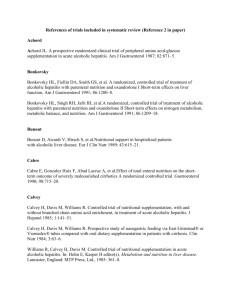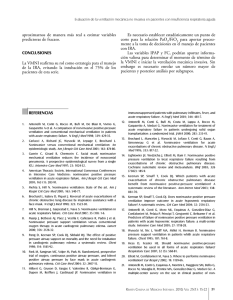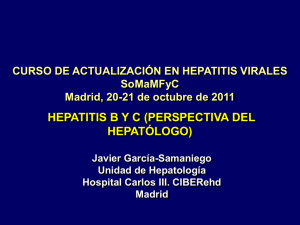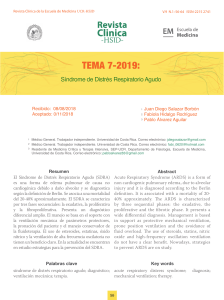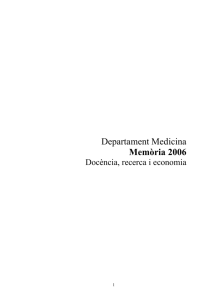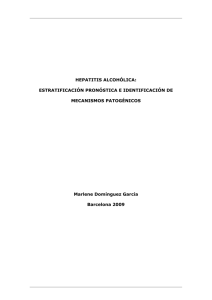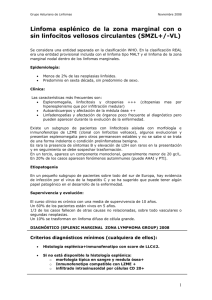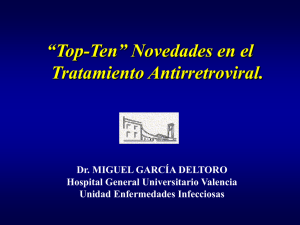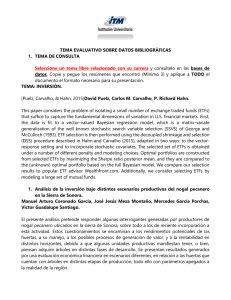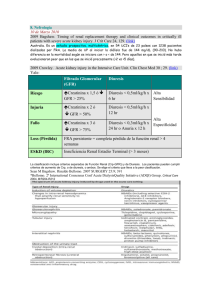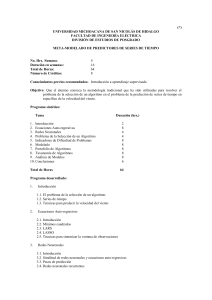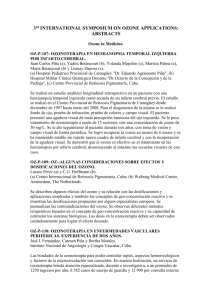Insuficiencia Hepática
advertisement
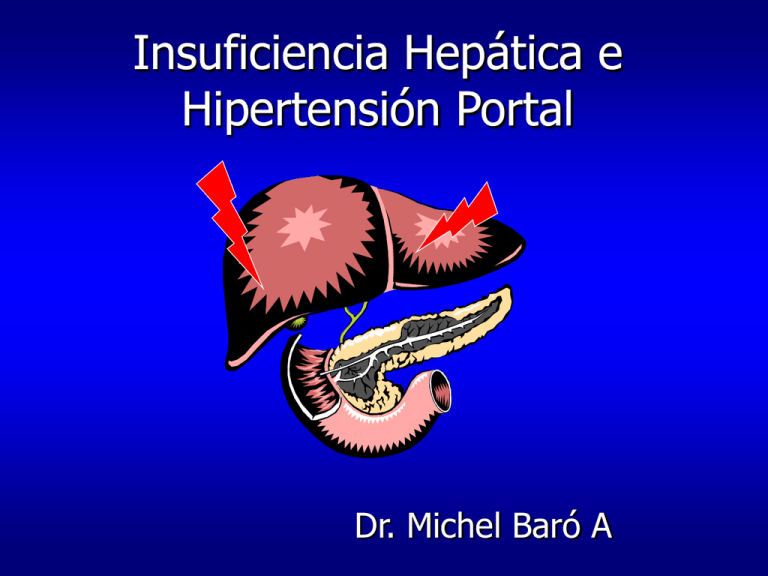
Insuficiencia Hepática e Hipertensión Portal Dr. Michel Baró A agudo Daño Hepático necrosis regeneración Insuficiencia hepática encefalopatía hepática crónico cirrosis hipertensión portal hepatocarcinoma Funciones del hígado: Digestión Síntesis de la bilis Detoxificación hormonas y compuestos extraños Biosíntesis Síntesis factores de coagulación, albúmina Energía del Metabolismo Metabolismo de glúcidos, proteínas, grasas Otras Funciones Filtración y almacenamiento de sangre Almacenamiento de vitaminas y hierro Tests de evaluación del hígado “Pruebas (daño) hepáticas” • • • • • • • GOT/ASAT GPT/ALAT Bilirrubina total Bilirrubina directa Fosfatasas alcalinas GGT LDH Tests de función hepática • • • • Albúmina Protrombina Colesterol total Amonemia • Bromosulftaleína • Verde indocianina hipoglicemia hemorragia Disminución síntesis edema Insuficiencia hepática ictericia Disminución depuración encefalopatía hiperestrogenismo Estimated prevalence of common causes of acute liver failure worldwide Principal causes of acute liver failure Table 7-2. Principal Causes of Acute-Liver Failure Drug-related hepatotoxicity Acetaminophen Idiosyncratic drug reactions Indeterminate etiology Viral hepatitis Acute hepatitis B Acute hepatitis A Others (hepatitis E, others rare) Autoimmune hepatitis Ischemic liver injury Cardiogenic "shock" Other (eg, cocaine, methamphetamines, ephedrine) Miscellaneous causes Wilson disease Budd-Chiari syndrome Acute fatty liver of pregnancy Malignancy Veno-occlusive disease Toxinas (micetismo) Reactivation of inactive hepatitis B after chemotherapy (A) Acetaminophen metabolic pathway N-acetyl-p-benzoquinoneimine Acetaminophen toxicity nomogram Drugs implicated in idiosyncratic liver injury leading to acute liver failure Table 7-6. Drugs Implicated in Idiosyncratic Liver Injur y Leading to Acute Liver Failure Infrequent But Not Rare Rare Combination Agents with Enhanced Toxicity Isoniazid Didanosine Ethanol-acetaminophen Sulfonamides Sustiva (efavirenz) Trimethoprim-sulfamethoxazole Phenytoin Metformin Rifampin-isoniazid "Statins" Ofloxacin Propylthiouracil Ketoconazole Halothane Meth yldopa Disulfiram Allopurinol Valproate Nefazodone Amiodarone Quetiapine Dapsone Isoflurane * Bromfenac Troglitazone Herbals † Lisinopril * Nicotinic acid Imipramine Gemtuzumab Ecstasy (methylenedioxymethamphetamine) Labetalol Etoposide Flutamide Tolcapone * Removed from the market. † Usually combinations of various herbal agents. Acute liver failure caused by Wilson disease Table 7-7. Acute Liver Failure Caused by Wilson Disease Most patients are younger than 30 y Non-immune hemolytic anemia is often present with high bilirubin levels (> 20 mg/dL) Kayser-Fleischer rings may be absent Alkaline phosphatase levels may be depressed Serum ceruloplasmin is typically decreased, but it may be normal in 15% of cases Serum uric acid is often very low secondary to a renal tubular defect Almost universally fatal without hepatic transplantation Female: male ratio, 2:1 Basic physical findings in acute liver failure Cerebral edema on CT scanning in a patient with acute liver failure (A) Physical findings in patients with advanced hepatic encephalopathy and cerebral edema Oxygen delivery curve Renal parameters in acute liver failure Table 7-13. Renal Parameters in Acute Liver Failure Hemodynamic changes Hypotension High cardiac output Low systemic vascular resistance Tachycardia Possible lactic acidosis Serum factors elevated Renin Aldosterone Tumor necrosis factor-α Prostaglandins Urine findings Low urine volume * Low urinary sodium Increased potassium Increased urinary urobilinogen * Presence of high urinary volume suggests tubular necrosis. Intraoperative photographs of related living-donor liver transplantation (A) Intraoperative photographs of related living-donor liver transplantation (B) Massive liver necrosis secondary to halothane anesthesia Histologic findings in a selection of patients with acute liver failure (A) Histologic findings in a selection of patients with acute liver failure (B). Acetoaminofeno Histologic findings in a selection of patients with acute liver failure (C): Halotano Histologic findings in a selection of patients with acute liver failure (D): Halotano Histologic findings in a selection of patients with acute liver failure (E): sindrome de Reye Histologic findings in a selection of patients with acute liver failure (F): Enfermedad de Wilson Histologic findings in a selection of patients with acute liver failure (G): Melanoma Histologic findings in a selection of patients with acute liver failure (H): Tuberculosis Histologic findings in a selection of patients with acute liver failure (I): Amiloidosis Histologic findings in a selection of patients with acute liver failure (J): Miocardiopatía Encefalopatía hepática NEUROTOXINAS: •Amomio •Aumento transporte aa neutrales (BHE) •Aumento osmolalidad astrocitos •Alteración actividad electrica •Oxindole ALTERACIÓN DE LA BHE ALTERACIÓN DE LA NEUROTRANSMISIÓN: •GABA •Glutamato ALTERACIÓN DEL METABOLISMO •Catecolaminas ENERGÉTICO CEREBRAL •Serotonina •Histamina •Melatonina EDEMA CEREBRAL HIPOPERFUSIÓN CEREBRAL ATROFIA CORTICAL Encefalopatía hepática •Amonio, Producido en: •intestino •Enterocitos •flora comensal, •H. pylori •Detoxificación •Hepática •Muscular Glutamina (interfiere fx mitocondrial del astrocito) •Aumenta por •Disminución del aclaramiento hepático •Shunting (TIPS) Encefalopatía hepática •Aumento transporte aa neutrales (BHE) •Aumento actividad transportador de L-aminoácidos •Aumento transporte de triptófano, tirosina y fenilalanina •Alteración síntesis dopamina, norepinefrina y serotonina •Aumento osmolalidad astrocitos •Acumulación de glutamina en astrocitos •Efecto sólo en ratas con shunt •Vasodilatación cerebral vía NO •Alteración actividad electrica •Inhibición de potenciales postsinápticos excitatorios e inhibitorios •Oxindole: Metabolito tóxico del triptófano Encefalopatía hepática ALTERACIÓN DE LA NEUROTRANSMISIÓN: •GABA: •Producido por flora comensal del intestino y detoxificado en el hígado •Complejo neurotransmisor GABA-benzodiacepina: inhibidor SNC •Animales expuestos al amonio o manganeso aumentan la expresión del gen del receptor de benzodiazepina del astrocito •Glutamato •Disminución del glutamato cerebral total •Aumento del glutamato extracelular •Catecolaminas •Disminución de la norepinefrina cerebral Ammonia and glutamate metabolism in the brain Hepatic encephalopathy: assessment of mental status Asterixis Blood ammonia concentration in hepatic encephalopathy Laennec’s cirrhosis and encephalopathy (A) Laennec’s cirrhosis and encephalopathy (B) Factors precipitating acute episodes of encephalopathy (diuréticos) Precipitants of hepatic encephalopathy in cirrhotic patients Drugs Benzodiazepines Narcotics Alcohol Increased ammonia production, absorption or entry into the brain Excess dietary intake of protein Gastrointestinal bleeding Infection Electrolyte disturbances such as hypokalemia Constipation Metabolic alkalosis Dehydration Vomiting Diarrhea Hemorrhage Diuretics Large volume paracentesis Portosystemic shunting Radiographic or surgically placed shunts Spontaneous shunts Vascular occlusion Portal vein thrombosis Hepatic vein thrombosis Primary hepatocellular carcinoma
